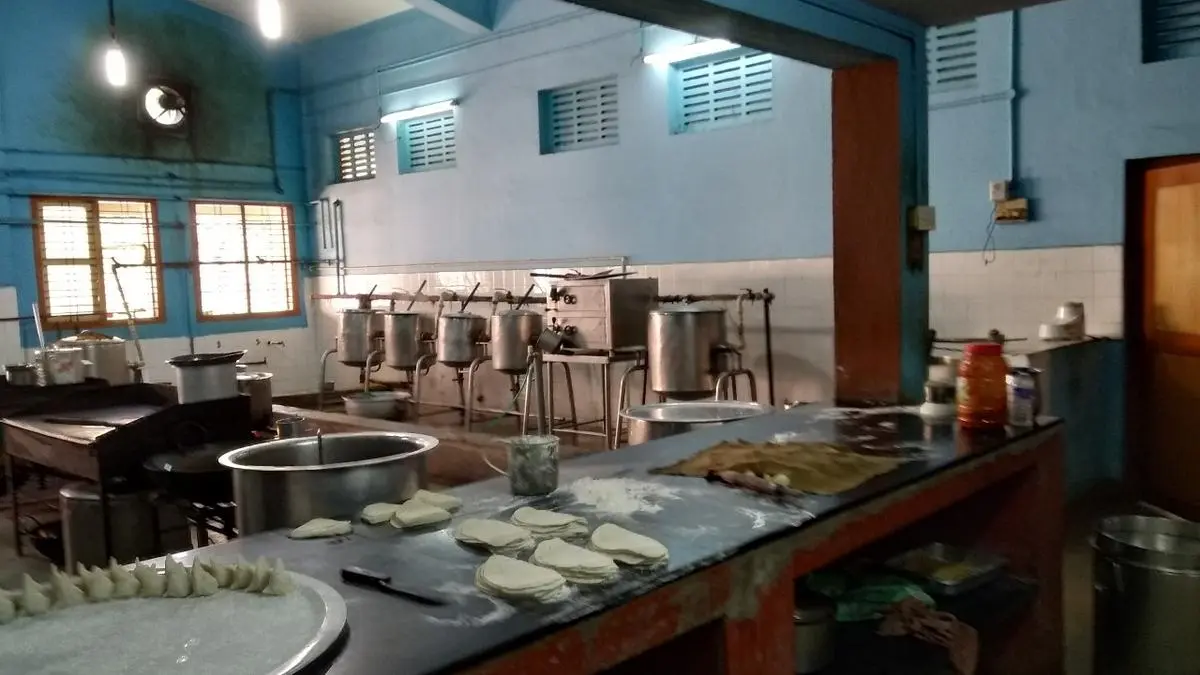A view of a community kitchen.
From a recent study entitled ‘Assessment of health risks as a result of inhalation of respiratory particles generated in the community kitchens’, has shown that concentrations of particles (PM) considerably exceed the acceptable air quality standards of Dakshina Kannada district.
The study – written by K Sudeep Kumara and N Karunakara from Mangalore University, YS Mayya of the Indian Institute of Technology (Bombay) and Pratim Biswas from University of Miami, and published in ‘Journal of Environmental Monitoring and Assessment’ has recommended the authority in the Air quality – Community kitchens.
The study included 15 community kitchens in Dakshina Kannada and was aimed at measuring PM1P.M2.5and PM10 Particles in the air that are known to penetrate deep into the lungs and then into the bloodstream.
Building pollution
The findings showed that PM concentrations considerably exceeded the standards for acceptable air quality, especially during cooking hours. The PM1P.M2.5 and PM10 Concentrations varied in reaching 40-286 µg m-3 (Microgram per cubic meter), 58-418 µg m-3 and 62-434 µg M-3 respectively, with corresponding average values of 74 µg m-3 111 µg M-3 and 119 µg M-3 .
PM concentration levels recommended by the World Health Organization (WHO) for indoor air were 5 µg mm-3 and 15 µg m-3 For PM2.5 and PM10respectively.
Karunakara, coordinator of the Center for Advanced Research in Environmental Radioactivity (Carer), said that the study has revealed the structure of polluting concentrations in kitchens that are characterized by insufficient ventilation. It has also shown that the exposure to employees is higher in kitchens using solid biofuel compared to other fuels such as LPG, he said.
Health risk assessments based on the measured data indicated that kitchen workers are exposed to increased health risks. The findings underline the importance of effective ventilation systems when reducing inhalation -related health risks and guaranteeing safer inner conditions for kitchen workers.
Insight into the environment
He told lineThat the study also lays the foundation for large -scale environmental health monitoring, adaptable to various climatic and infrastructure conditions throughout India and then.
An extensive, long -term study of indoor air pollution, especially with cooking consumption, to generate a robust database is important. Such a study is especially important for a country such as India because of its great population density and various climatic conditions, he said, adding a long -term study focused on this region would be scientifically valuable, because it could offer insight into the poorer indoor quality the lifespan and quality of life of the majority of our population could influence. “This would significantly contribute to our understanding of the broader environmental factors that influence air quality indoors, with important implications for public health and air quality management,” he said.
This study is the first of its kind that accurately investigates the exposure of employees in Indian community kitchens at different sizes of particles, causing light to shed on the corresponding health risks, he said. India, with the world’s largest population, adds meaning to the relevance and implications of this research. Moreover, it is expected that this study will increase awareness among members of the community and officials about air quality problems and promote practices that reduce pollution, he said.
To create consciousness
PL Dharma, Vice Chancellor of Mangalore University, said that the findings of this study will create consciousness in society, help with transformation into alternative and clean source of energy instead of firewood in community kitchens and the use of technologically advanced equipment.
Community kitchens work in old houses, schools and colleges, which serve a large population of different age groups. Professionals and those involved in serving the food, cleaning work and supporting staff in these kitchens, and they spend a lot of time in the kitchens and are exposed to higher concentrations of PM. The study was aimed at the consciousness of the higher levels of air pollution to which these groups are exposed, said Karunakara.
Advanced real-time air quality monitoring devices (APT-Maxima by applied particle technology Inc, US) that measure particle socket distribution of 0.3 µm (micrometer) to> 10 µm (micrometer) were used in this study. Continuous and real-time monitoring of PM concentrations was performed for 15 to 20 days.
The continuous monitoring enabled the researchers to set up the essential database about air pollution levels in community kitchens for which previous studies do not exist. The kitchens that are included in the research, served large populations in schools, hostels, restaurants and afternoon meal programs, which reflect typical cooking environments in India. The study was implemented by Carer from Mangalore University.
Published on June 19, 2025
#Study #finds #community #community #air #quality #exceeds #safety #levels #Dakshina #Kannada





